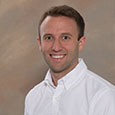Faculty Profiles
Justin Sparks Associate Professor, Chemistry |  |
Education
- Ph.D., chemistry, The Pennsylvania State University
- B.S., chemistry, DeSales University
Teaching Interests
Why are the intricate workings of atoms and molecules relevant to our everyday lives? Why are certain combinations/arrangements of atoms utilized to fabricate the screen that you are using to read this? Discussing relatable questions like these in my physical chemistry and materials science courses leads to an impactful, lasting learning experience for each individual learner. Within this dialogue, I emphasize the interconnected nature of scientific principles to help students organize seemingly complicated topics into a cohesive concept network. Understanding unifying themes also helps students develop both a predictive intuition for solving complex problems and a skill set for independently learning new material. In the ever-expanding field of science, this capacity for lifelong learning is indispensable. Thus, my objective as a professor is to not only teach the course content in an engaging and enduring manner but to also ingrain a passion and curiosity to continually ask, and seek answers to, "why?".
Research, Scholarship or Creative/Artistic Interests
Traditionally, chemists follow a familiar tenet where the physical and chemical properties of molecules are controlled by changing the constituent atoms and/or the way in which those atoms are bonded together. Strong coupling is an alternative paradigm, where, instead, molecular properties are altered without changing the elements, bonds, or geometry in a formal sense. When a molecule is placed in an optical cavity (between two mirrors spaced apart by approximately one tenth of the thickness of your hair), a photon emitted from the molecule has an increased probability of being reflected back, reabsorbed, and emitted again. This oscillation of energy between the optical cavity and the molecule results in the formation of new quantum states, known as polaritons, that are composed of both light and matter. By coupling, or "mixing", light with matter, my research group modifies the characteristics of molecules in an effort to access novel chemistries that are unattainable by traditional means.
Professional Website
